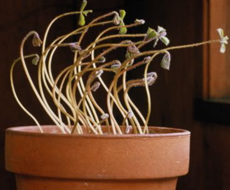Agriculture
Heliotropism is a growth movement in plants that is induced by sunlight. It is sometimes called solar tracking, a directional response to the sun. Because plants react in a similar way toward artificial sources of light, heliotropism is sometimes termed phototropism, a growth movement induced by any light stimulus.
Plants that orient their leaves to receive maximum sunlight are called diaheliotropic. Diaheliotropism is the tendency of leaves or other organs of a plant to track the sun by turning their surfaces toward it. Tracking the sun maximizes the amount of direct solar radiation received. Diaheliotropic movements can increase radiation interception, enhance photosynthesis, and increase growth rates of plants.
Plants that move their leaves to avoid sunlight are called paraheliotropic. Paraheliotropism is a plant response to minimize surface exposure to the sun. By orienting leaves and other plant organs parallel to the sun?s rays, light absorption is minimized. It is a process that some plants use to reduce dehydration by reducing leaf temperatures and water loss during times of drought.
Solar Tracking
Alfalfa, cotton, soybean, bean, and some wild species of the mallow family Malvaceae are plant species that exhibit solar tracking. Heliotropic plants change the orientation of their leaves toward the sun.
This solar tracking mechanism can occur as a continuous adjustment throughout the day so that the leaf blades are always oriented perpendicular to the sun?s rays. The leaves are in a nearly vertical position, facing the eastern horizon as the sun rises.
During the morning and later afternoon, when solar radiation is not at its most intense, the leaves move to a horizontal orientation.When there is increased solar radiation near midday, the leaves move to become more vertical so that they are not damaged by overheating.
At sunset, the leaves are nearly vertical, facing the west when the sun sets. During the night, the leaves assume a horizontal position and reorient just before dawn, to start the solar tracking cycle over again. Leaves only track the sun on clear days. They stop when clouds block the sun.
Mechanisms
In many cases, the leaves of solar tracking plants are controlled by a specialized organ called the pulvinus. This organ is a swollen part of the petiole that may occur where it joins the stem, the leaf blade, or both.
It contains motor cells that generate mechanical forces that control the orientation of the petiole and thus the leaf blade. The forces are produced by changes in the turgor in the pulvinus.
The cells of this organ have highly elastic cell walls that allow them readily to change size and shape. The cells of the upper pulvinus have the capability of increasing their turgidity with water uptake, while the lower pulvinus can lose water very easily. The net effect is a force that moves the petiole.
Another mechanism producing heliotropism is produced by small mechanical changes along the length of the petiole and by movements of the younger parts of the stem. Heliotropic plants are continuously moving their leaves, leaflets, and pinnules to readjust to prevailing light conditions. Movements occur rather rapidly, every fifteen to sixty seconds, which is just slow enough to be imperceptible to most humans.
- Gas Exchange In Plants
Gas Exchange in PlantsGas exchange is the process whereby water vapor and oxygen leave and carbon dioxide enters plant leaves. The gaseous balance in plants is quite complex because plant cells carry on both respiration and photosynthesis. All living...
- Leaf Anatomy
Leaf Anatomy The leaf has evolved as the chief part of the plant for gathering light energy from the sun and conducting photosynthesis to transform that light energy into biochemical energy. Hence, its structure is adapted to that function. Leaves are...
- Leaf Lobing And Division
Leaf Lobing and DivisionThe pattern of leaf lobes (projections) or divisions, leaf arrangement, the number, and the shape of leaflets composing compound leaves are often useful characteristics for identification of plants. Leaves, the main photosynthetic...
- Leaf Shapes
Leaf ShapesThe overall shapes of leaves and leaflets are often characteristic of individual species of plants and, together with reproductive features, are used in plant identification. To assess the shape of a leaf, one examines the outline formed by...
- Nastic Movements
Nastic MovementsPlants, unlike animals, are sedentary organisms, but they are capable of some limited movements. These include nastic movements, which enable plants to adapt rapidly to changes in their environment by changing orientation. Nastic movements...
Agriculture
Heliotropism
 |
| Heliotropism |
Plants that orient their leaves to receive maximum sunlight are called diaheliotropic. Diaheliotropism is the tendency of leaves or other organs of a plant to track the sun by turning their surfaces toward it. Tracking the sun maximizes the amount of direct solar radiation received. Diaheliotropic movements can increase radiation interception, enhance photosynthesis, and increase growth rates of plants.
Plants that move their leaves to avoid sunlight are called paraheliotropic. Paraheliotropism is a plant response to minimize surface exposure to the sun. By orienting leaves and other plant organs parallel to the sun?s rays, light absorption is minimized. It is a process that some plants use to reduce dehydration by reducing leaf temperatures and water loss during times of drought.
Solar Tracking
Alfalfa, cotton, soybean, bean, and some wild species of the mallow family Malvaceae are plant species that exhibit solar tracking. Heliotropic plants change the orientation of their leaves toward the sun.
 |
 |
This solar tracking mechanism can occur as a continuous adjustment throughout the day so that the leaf blades are always oriented perpendicular to the sun?s rays. The leaves are in a nearly vertical position, facing the eastern horizon as the sun rises.
 |
| Solar Tracking |
At sunset, the leaves are nearly vertical, facing the west when the sun sets. During the night, the leaves assume a horizontal position and reorient just before dawn, to start the solar tracking cycle over again. Leaves only track the sun on clear days. They stop when clouds block the sun.
Mechanisms
In many cases, the leaves of solar tracking plants are controlled by a specialized organ called the pulvinus. This organ is a swollen part of the petiole that may occur where it joins the stem, the leaf blade, or both.
It contains motor cells that generate mechanical forces that control the orientation of the petiole and thus the leaf blade. The forces are produced by changes in the turgor in the pulvinus.
 |
| Mechanisms |
Another mechanism producing heliotropism is produced by small mechanical changes along the length of the petiole and by movements of the younger parts of the stem. Heliotropic plants are continuously moving their leaves, leaflets, and pinnules to readjust to prevailing light conditions. Movements occur rather rapidly, every fifteen to sixty seconds, which is just slow enough to be imperceptible to most humans.
- Gas Exchange In Plants
Gas Exchange in PlantsGas exchange is the process whereby water vapor and oxygen leave and carbon dioxide enters plant leaves. The gaseous balance in plants is quite complex because plant cells carry on both respiration and photosynthesis. All living...
- Leaf Anatomy
Leaf Anatomy The leaf has evolved as the chief part of the plant for gathering light energy from the sun and conducting photosynthesis to transform that light energy into biochemical energy. Hence, its structure is adapted to that function. Leaves are...
- Leaf Lobing And Division
Leaf Lobing and DivisionThe pattern of leaf lobes (projections) or divisions, leaf arrangement, the number, and the shape of leaflets composing compound leaves are often useful characteristics for identification of plants. Leaves, the main photosynthetic...
- Leaf Shapes
Leaf ShapesThe overall shapes of leaves and leaflets are often characteristic of individual species of plants and, together with reproductive features, are used in plant identification. To assess the shape of a leaf, one examines the outline formed by...
- Nastic Movements
Nastic MovementsPlants, unlike animals, are sedentary organisms, but they are capable of some limited movements. These include nastic movements, which enable plants to adapt rapidly to changes in their environment by changing orientation. Nastic movements...


